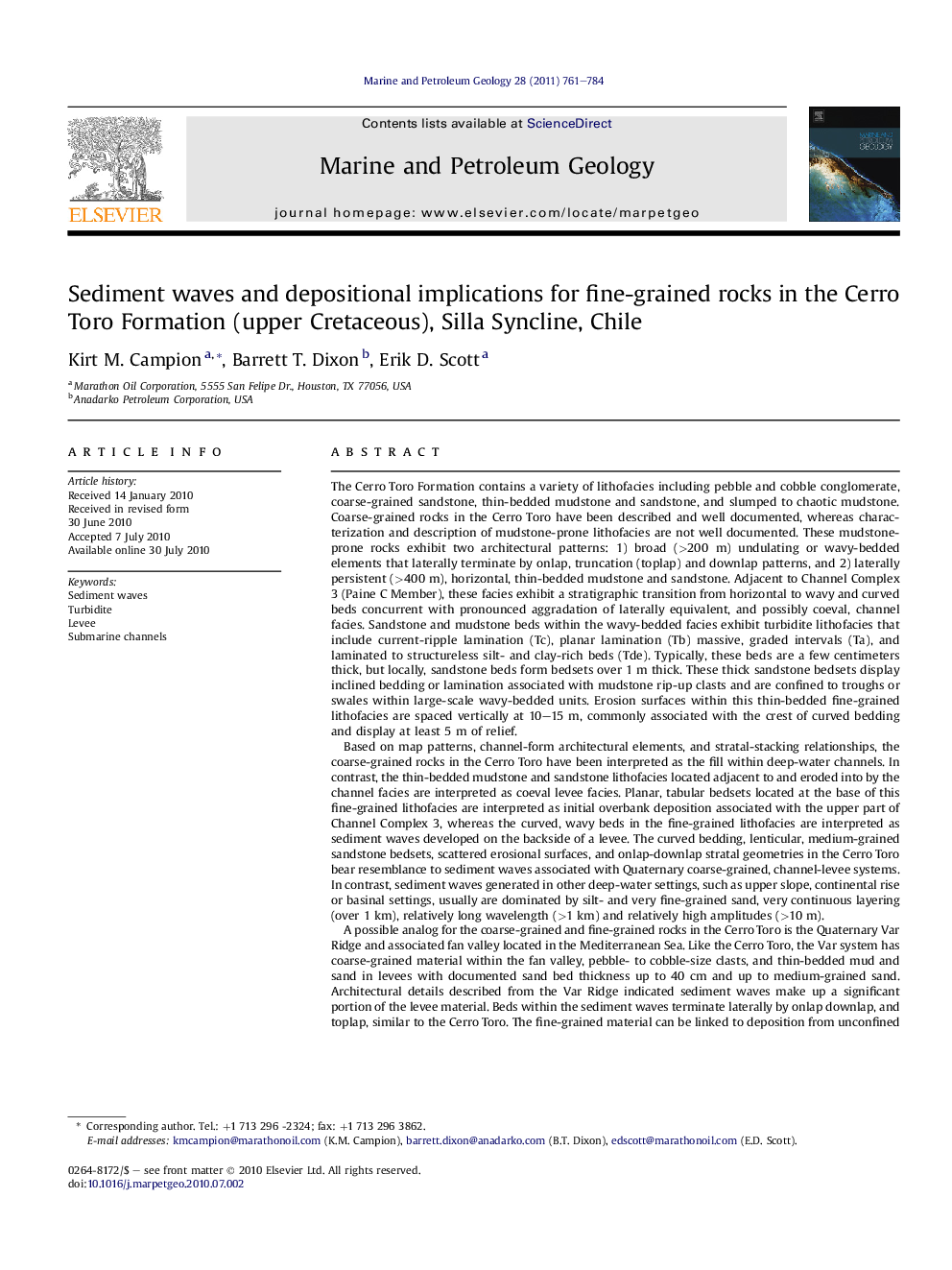| کد مقاله | کد نشریه | سال انتشار | مقاله انگلیسی | نسخه تمام متن |
|---|---|---|---|---|
| 4696073 | 1351654 | 2011 | 24 صفحه PDF | دانلود رایگان |

The Cerro Toro Formation contains a variety of lithofacies including pebble and cobble conglomerate, coarse-grained sandstone, thin-bedded mudstone and sandstone, and slumped to chaotic mudstone. Coarse-grained rocks in the Cerro Toro have been described and well documented, whereas characterization and description of mudstone-prone lithofacies are not well documented. These mudstone-prone rocks exhibit two architectural patterns: 1) broad (>200 m) undulating or wavy-bedded elements that laterally terminate by onlap, truncation (toplap) and downlap patterns, and 2) laterally persistent (>400 m), horizontal, thin-bedded mudstone and sandstone. Adjacent to Channel Complex 3 (Paine C Member), these facies exhibit a stratigraphic transition from horizontal to wavy and curved beds concurrent with pronounced aggradation of laterally equivalent, and possibly coeval, channel facies. Sandstone and mudstone beds within the wavy-bedded facies exhibit turbidite lithofacies that include current-ripple lamination (Tc), planar lamination (Tb) massive, graded intervals (Ta), and laminated to structureless silt- and clay-rich beds (Tde). Typically, these beds are a few centimeters thick, but locally, sandstone beds form bedsets over 1 m thick. These thick sandstone bedsets display inclined bedding or lamination associated with mudstone rip-up clasts and are confined to troughs or swales within large-scale wavy-bedded units. Erosion surfaces within this thin-bedded fine-grained lithofacies are spaced vertically at 10–15 m, commonly associated with the crest of curved bedding and display at least 5 m of relief.Based on map patterns, channel-form architectural elements, and stratal-stacking relationships, the coarse-grained rocks in the Cerro Toro have been interpreted as the fill within deep-water channels. In contrast, the thin-bedded mudstone and sandstone lithofacies located adjacent to and eroded into by the channel facies are interpreted as coeval levee facies. Planar, tabular bedsets located at the base of this fine-grained lithofacies are interpreted as initial overbank deposition associated with the upper part of Channel Complex 3, whereas the curved, wavy beds in the fine-grained lithofacies are interpreted as sediment waves developed on the backside of a levee. The curved bedding, lenticular, medium-grained sandstone bedsets, scattered erosional surfaces, and onlap-downlap stratal geometries in the Cerro Toro bear resemblance to sediment waves associated with Quaternary coarse-grained, channel-levee systems. In contrast, sediment waves generated in other deep-water settings, such as upper slope, continental rise or basinal settings, usually are dominated by silt- and very fine-grained sand, very continuous layering (over 1 km), relatively long wavelength (>1 km) and relatively high amplitudes (>10 m).A possible analog for the coarse-grained and fine-grained rocks in the Cerro Toro is the Quaternary Var Ridge and associated fan valley located in the Mediterranean Sea. Like the Cerro Toro, the Var system has coarse-grained material within the fan valley, pebble- to cobble-size clasts, and thin-bedded mud and sand in levees with documented sand bed thickness up to 40 cm and up to medium-grained sand. Architectural details described from the Var Ridge indicated sediment waves make up a significant portion of the levee material. Beds within the sediment waves terminate laterally by onlap downlap, and toplap, similar to the Cerro Toro. The fine-grained material can be linked to deposition from unconfined turbidity currents that were generated via overbank flows from the Var fan channel. The development of these architectural elements requires out of channel turbidity currents and relatively thick flows. Growth of the sediment waves in the Var system represents active sedimentation and turbidity currents within a coeval channel rather than development during periods of channel inactivity or degradation.
Journal: Marine and Petroleum Geology - Volume 28, Issue 3, March 2011, Pages 761–784